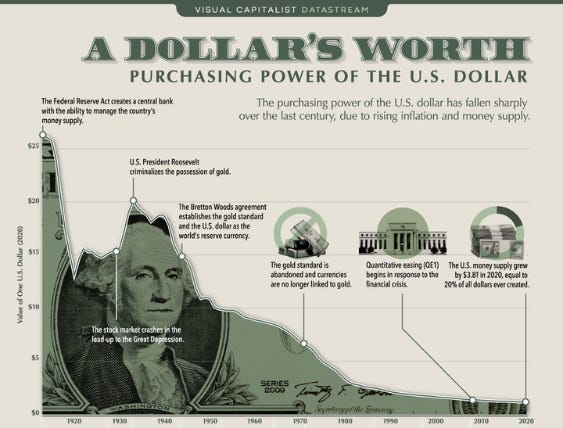Hello Tribe Vibers!
🌍 The world seems to be having a melt down over the tariffs introduced by the White House this week (Liberation Day?). Suddenly, everyone you know is a tariff “expert”. Wall Street is at the panic station, but main street seems largely unbothered. Why? Because 88% equities are owned by 10% of Americans, who have been benefiting from inflated stock market prices. This correction has less effect on 90% of Americans, who couldn’t give two shits if your stock portfolio takes a hit.
Amongst a sea of differing opinions, we highlight three viewpoints from Becca Bratcher for Forbes on why this is a good time to buy Bitcoin, Kevin Corinth and Stan Veuger on why Trumps tariff calculations are wrong, and Anthony Pompliano on why they will strengthen the U.S. economy. You decide.
Learn about economics with one of the world’s greatest economists, Saifedean Ammous, for just $100 USD a year, and if you are in Calgary, join a Bitcoin Walk April 12th to burn some calories and learn about Bitcoin.
Editorial Note
Welcome to another exciting week in Bitcoin! Coming up:
🎓 Bitcoin 101: Your weekly resource to learn about Bitcoin
🗞 News: Trending News in Bitcoin
👩💼 Women in Bitcoin: Where the Bitcoin “Femergy” is happening
📆 Events: Bitcoin events online and across the globe
🎧 & 🎥Vibe of the Week: Our content recommendations
🎓 Bitcoin 101: Learn “Real” Economics
Traditionally, there are two dominant schools of economic thought:
Keynsian Economics (most frequently taught at educational institutions)
Austrian Economics
Keynesian vs. Austrian Economics: Core Differences
Keynesian Economics
Focus: Governments should actively manage economic cycles through fiscal spending and monetary policy.
Money Supply: Supports temporary increases in money supply during recessions to boost demand, even if it risks inflation.
Example: Post-2008 stimulus packages averted deeper crises but contributed to long-term inflationary pressures.
Austrian Economics
Focus: Free markets self-regulate best. Government intervention (e.g., money printing) distorts prices and creates unsustainable booms.
Money Supply: Argues all artificial expansion debases currency, causing inflation and market corrections (e.g., 2008 housing crash).
Example: Advocates for sound money (e.g., gold standards) to prevent boom-bust cycles.
Who is right? You decide:
Learn from one of the best! Saifedean Ammous, author of The Bitcoin Standard and The Fiat Standard
Saifedean runs an online economics course that costs just $100 x year. This is a considerable saving vs a largely worthless economics degree.
👉 Sign up HERE
“When users join Saifedean.com, they gain access to all four online economics courses, Saifedean’s books, and forum membership. They can also participate in weekly discussion seminars covering Bitcoin, economics, and a variety of related topics.”
📈 Trending News
1. THE SUMMARY: Why Tariffs Make Now A Strategic Time To Buy Bitcoin
Becca Bratcher for Forbes
The Scoop🕵️♂️: President Trump’s April 2025 tariffs sparked a major market crash, with the S&P 500 down 4.8% and gold falling. Bitcoin dropped 5% but rebounded to $83K, outperforming traditional assets. BlackRock’s CEO warned that U.S. debt growth threatens the dollar’s dominance, boosting interest in alternatives like Bitcoin.
Why You Should Care🚨: Rising debt and tariffs expose weaknesses in traditional finance. Bitcoin’s stability during the selloff positions it as a hedge against inflation and dollar instability, appealing to investors fleeing volatile markets.
What This Means for Bitcoin ✨: Bitcoin’s fixed supply and scarcity via halvings strengthen its role as a “digital gold.” Analysts see it as a safe haven amid fiscal chaos, with institutions like BlackRock hinting it could rival traditional stores of value.
📚 Read the full piece by Becca Bratcher for Forbes HERE
2. TARIFF CRITIQUE: President Trump’s Tariff Formula Makes No Economic Sense. It’s Also Based on an Error
by Kevin Corinth and Stan Veuger
The Scoop🕵️♂️: Kevin and Stan claim that Trump’s tariff calculation is incorrect. Here is why:
The CalculationTrump’s team used this formula for each country:
Trade deficit ÷ Imports → This gives a percentage (e.g., if the U.S. imports $100M and has a $50M deficit, the deficit is 50% of imports).
Halve that percentage → “To be kind,” Trump claimed (e.g., 50% becomes 25%).
Minimum 10% tariff → Even if the math gives a lower number, the tariff can’t drop below 10%.
Why they believe it’s Wrong
Ignores basic economics:
Trade deficits aren’t caused just by tariffs. They depend on factors like supply chains, consumer preferences, and currency values. For example, the U.S. might import more from Vietnam because it makes cheap electronics, not because Vietnam has high tariffs.
As the Tax Foundation notes, the formula falsely assumes tariffs alone dictate trade balances.
Math error inflates tariffs:
The formula wrongly uses retail price elasticity (how store prices react to tariffs) instead of import price elasticity (how tariffs affect import costs).
This mistake quadruples the tariffs. For example, Lesotho’s 50% tariff should be 13.2% if calculated correctly (AEI).
Hurts poor countries:
Small, poor nations like Madagascar or Laos face tariffs as high as 50%, even though their trade impact is minimal (Reuters).
Economists’ Take
Nouriel Roubini (NYU): The formula is “totally flawed” because it wrongly assumes trade should balance to zero (Business Insider).
📚 Read the full breakdown of the argument HERE.
3. TARIFF SUPPORT: Tariffs Will Strengthen The American Economy
from Anthony Pompliano - The Pomp Lettter
The Scoop🕵️♂️: President Trump announced sweeping tariffs (10% baseline, up to 50% on select countries) to shift from punishing foreign trade practices to incentivizing U.S. manufacturing. Markets initially plunged, but Pompliano argues this policy will boost domestic production, create jobs, and generate government revenue by pressuring companies to “make in America” or face higher costs.
Why You Should Care🚨: Pompliano claims tariffs will correct decades of “unfair” foreign trade practices (subsidies, currency manipulation) and prioritize U.S. workers. He dismisses inflation fears, citing Walmart’s ability to force suppliers to absorb tariff costs, and insists the long-term economic benefits (onshoring jobs, reducing trade deficits) outweigh short-term market volatility.
What This Means for Bitcoin ✨: Pompliano implies Bitcoin benefits as tariffs expose traditional finance’s fragility. While not explicitly stated, his broader narrative aligns Bitcoin with economic sovereignty: Fixed supply and decentralization position it as a hedge against potential dollar devaluation, trade wars, and centralized policy risks. Investors seeking alternatives to volatile markets may increasingly turn to Bitcoin as a “digital gold.”
Pomp states: “But remember, there is one big loophole in this whole tariff kerfuffle you don’t have to deal with tariffs if you make products in America and you don’t have to deal with tariffs if you buy products made in America.”
💼 Women in Bitcoin - Tariff Take from Lyn Alden
Analyst, Lyn Alden always had a thoughtful take. Here is a recent post from her on tariffs and the stock market crash.
You can get her book “Broken Money” and subscribe to her newsletter HERE.
📆 Upcoming Events
Join a Bitcoin Walk - Calgary
Exciting news... we’re thrilled to announce that we’ll be hosting Calgary's Bitcoin Walks... a monthly meetup where Bitcoin enthusiasts and curious newcomers can come together, get some exercise, and engage in real-life conversations about the revolutionary potential of Bitcoin... 🚀💡
🎧 & 🎥 Vibe of the Week - B-Reel
Listen to the first episode of this Bitcoin podcast “B-Reel” with Tuur Demeester and Pierre Rochard.
Meme of the Week - I just bought more Bitcoin
Source: https://x.com/ProtestFiat/status/1907915865817039154
📺 &🎧 check out our conversations with Women in Bitcoin:
https://accesstribe.com/podcast
📆 Book a free 1 to 1 session with our founder to learn how to Buy and Custody Bitcoin safely:
👋 See you all next week for more Tribe Vibes!











